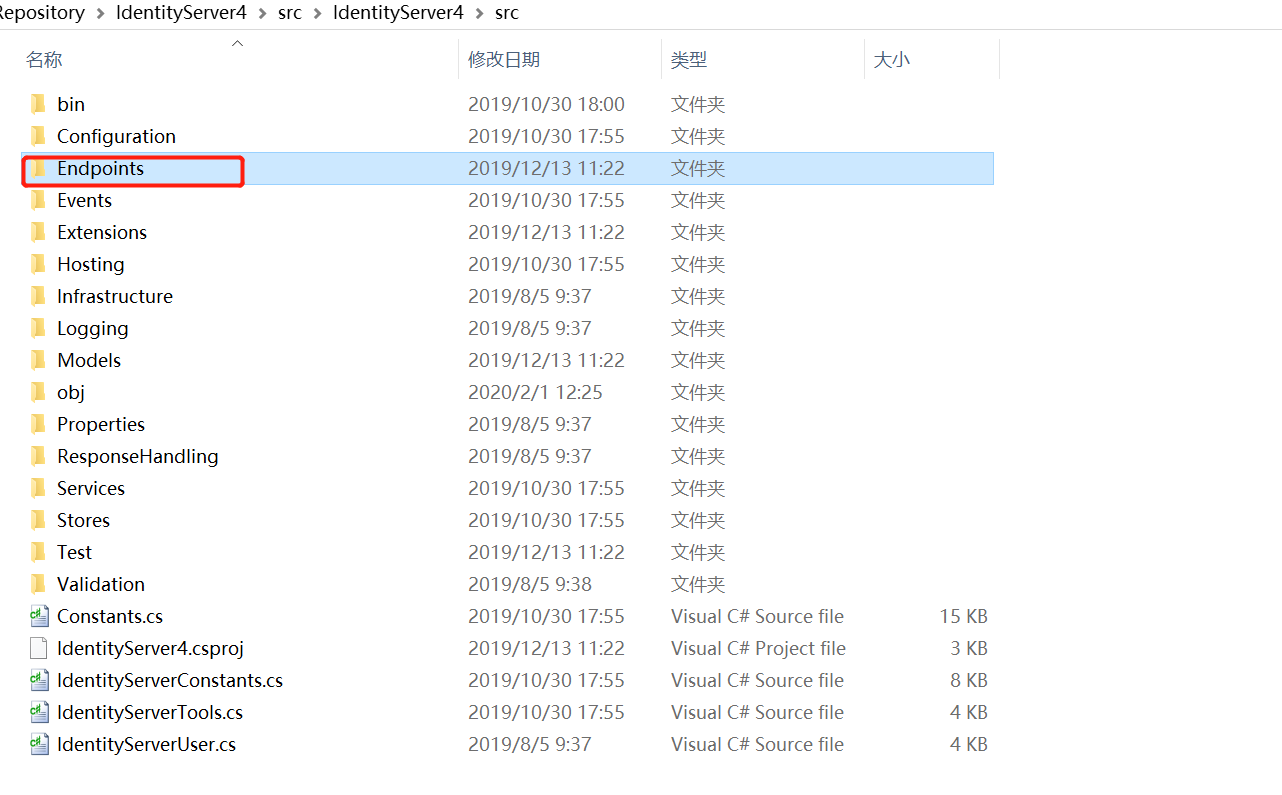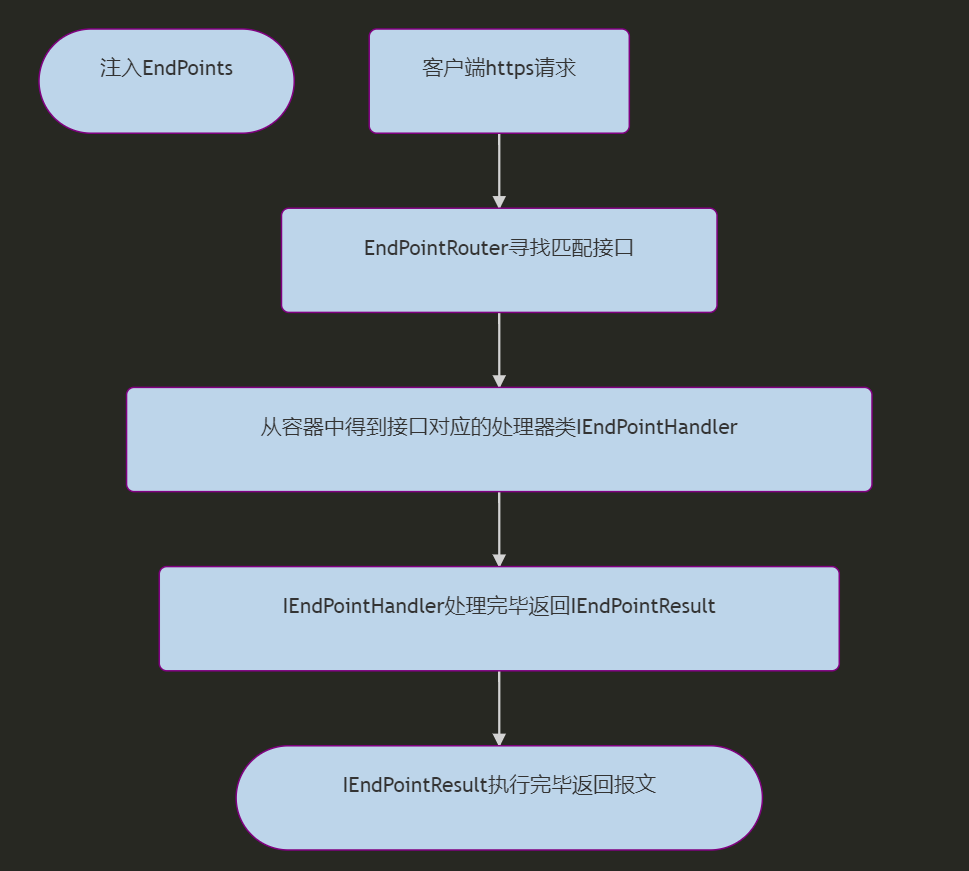目錄 "identityserver4源碼解析_1_項目結構" "identityserver4源碼解析_2_元數據介面" "identityserver4源碼解析_3_認證介面" "identityserver4源碼解析_4_令牌發放介面" "identityserver4源碼解析_5_查詢用戶信 ...
目錄
- identityserver4源碼解析_1_項目結構
- identityserver4源碼解析_2_元數據介面
- identityserver4源碼解析_3_認證介面
- identityserver4源碼解析_4_令牌發放介面
- identityserver4源碼解析_5_查詢用戶信息介面
- identityserver4源碼解析_6_結束會話介面
- identityserver4源碼解析_7_查詢令牌信息介面
- identityserver4源碼解析_8_撤銷令牌介面
簡介
Security源碼解析系列介紹了微軟提供的各種認證架構,其中OAuth2.0,OpenIdConnect屬於遠程認證架構,所謂遠程認證,是指token的頒發是由其他站點完成的。
IdentityServer4是基於OpenIdConnect協議的認證中心框架,可以幫助我們快速搭建微服務認證中心。
初學者可能看到生澀的概念比較頭疼,可以將OAuth, OpenIdConnect協議簡單理解成需求文檔,idsv4基於需求提供了一系列的api實現。
對於idsv還不太瞭解的可以看下麵的資料,本系列主要學習梳理idsv4的源碼,結合協議加深理解。
曉晨姐姐系列文章
官方文檔
項目結構
項目地址如下
克隆到本地,項目結構如圖

核心項目是IdentityServer4,其餘的都是與微軟框架集成、以及處理持久化的項目。
項目結構如圖。Endpoints文件夾就是介面文件,我們先看下依賴註入、中間件的代碼,然後看下每個介面。

依賴註入
public static IIdentityServerBuilder AddIdentityServer(this IServiceCollection services)
{
var builder = services.AddIdentityServerBuilder();
builder
.AddRequiredPlatformServices()
.AddCookieAuthentication()
.AddCoreServices()
.AddDefaultEndpoints()
.AddPluggableServices()
.AddValidators()
.AddResponseGenerators()
.AddDefaultSecretParsers()
.AddDefaultSecretValidators();
// provide default in-memory implementation, not suitable for most production scenarios
builder.AddInMemoryPersistedGrants();
return builder;
}
- AddRequiredPlatformServices - 註入平臺服務
- IHttpContextAccessor:HttpContext訪問器
- IdentityServerOptions:配置類
public static IIdentityServerBuilder AddRequiredPlatformServices(this IIdentityServerBuilder builder)
{
builder.Services.TryAddSingleton<IHttpContextAccessor, HttpContextAccessor>();
builder.Services.AddOptions();
builder.Services.AddSingleton(
resolver => resolver.GetRequiredService<IOptions<IdentityServerOptions>>().Value);
builder.Services.AddHttpClient();
return builder;
}
- AddCookieAuthentication - 註入cookie服務
- 註入名稱為idsrv的cookie認證架構
- 註入IAuthenticationService的實現IdentityServerAuthenticationService
- 註入IAuthenticationHandlerProvider的實現FederatedSignoutAuthenticationHandlerProvider
public static IIdentityServerBuilder AddCookieAuthentication(this IIdentityServerBuilder builder)
{
builder.Services.AddAuthentication(IdentityServerConstants.DefaultCookieAuthenticationScheme)
.AddCookie(IdentityServerConstants.DefaultCookieAuthenticationScheme)
.AddCookie(IdentityServerConstants.ExternalCookieAuthenticationScheme);
builder.Services.AddSingleton<IConfigureOptions<CookieAuthenticationOptions>, ConfigureInternalCookieOptions>();
builder.Services.AddSingleton<IPostConfigureOptions<CookieAuthenticationOptions>, PostConfigureInternalCookieOptions>();
builder.Services.AddTransientDecorator<IAuthenticationService, IdentityServerAuthenticationService>();
builder.Services.AddTransientDecorator<IAuthenticationHandlerProvider, FederatedSignoutAuthenticationHandlerProvider>();
return builder;
}
- AddCoreServices - 註入核心服務
/// <summary>
/// Adds the core services.
/// </summary>
/// <param name="builder">The builder.</param>
/// <returns></returns>
public static IIdentityServerBuilder AddCoreServices(this IIdentityServerBuilder builder)
{
builder.Services.AddTransient<SecretParser>();
builder.Services.AddTransient<SecretValidator>();
builder.Services.AddTransient<ScopeValidator>();
builder.Services.AddTransient<ExtensionGrantValidator>();
builder.Services.AddTransient<BearerTokenUsageValidator>();
builder.Services.AddTransient<JwtRequestValidator>();
// todo: remove in 3.0
#pragma warning disable CS0618 // Type or member is obsolete
builder.Services.AddTransient<BackChannelHttpClient>();
#pragma warning restore CS0618 // Type or member is obsolete
builder.Services.AddTransient<ReturnUrlParser>();
builder.Services.AddTransient<IdentityServerTools>();
builder.Services.AddTransient<IReturnUrlParser, OidcReturnUrlParser>();
builder.Services.AddScoped<IUserSession, DefaultUserSession>();
builder.Services.AddTransient(typeof(MessageCookie<>));
builder.Services.AddCors();
builder.Services.AddTransientDecorator<ICorsPolicyProvider, CorsPolicyProvider>();
return builder;
}
- AddDefaultEndpoints - 註入介面
- AuthorizeCallbackEndpoint:認證回調介面
- AuthorizeEndpoint:認證介面
- CheckSessionEndpoint:檢查會話介面
- DeviceAuthorizationEndpoint:設備認證介面
- DiscoveryEndpoint:元數據鍵介面
- DiscoveryEndpoint:元數據介面
- EndSessionCallbackEndpoint:結束會話回調介面
- EndSessionEndpoint:結束會話介面
- IntrospectionEndpoint:查詢令牌信息介面
- TokenRevocationEndpoint:撤銷令牌介面
- TokenEndpoint:發放令牌介面
- UserInfoEndpoint:查詢用戶信息介面
註入所有預設介面,包括介面名稱和地址。請求進來之後,路由類EndPointRouter通過路由來尋找匹配的處理器。
public static IIdentityServerBuilder AddDefaultEndpoints(this IIdentityServerBuilder builder)
{
builder.Services.AddTransient<IEndpointRouter, EndpointRouter>();
builder.AddEndpoint<AuthorizeCallbackEndpoint>(EndpointNames.Authorize, ProtocolRoutePaths.AuthorizeCallback.EnsureLeadingSlash());
builder.AddEndpoint<AuthorizeEndpoint>(EndpointNames.Authorize, ProtocolRoutePaths.Authorize.EnsureLeadingSlash());
builder.AddEndpoint<CheckSessionEndpoint>(EndpointNames.CheckSession, ProtocolRoutePaths.CheckSession.EnsureLeadingSlash());
builder.AddEndpoint<DeviceAuthorizationEndpoint>(EndpointNames.DeviceAuthorization, ProtocolRoutePaths.DeviceAuthorization.EnsureLeadingSlash());
builder.AddEndpoint<DiscoveryKeyEndpoint>(EndpointNames.Discovery, ProtocolRoutePaths.DiscoveryWebKeys.EnsureLeadingSlash());
builder.AddEndpoint<DiscoveryEndpoint>(EndpointNames.Discovery, ProtocolRoutePaths.DiscoveryConfiguration.EnsureLeadingSlash());
builder.AddEndpoint<EndSessionCallbackEndpoint>(EndpointNames.EndSession, ProtocolRoutePaths.EndSessionCallback.EnsureLeadingSlash());
builder.AddEndpoint<EndSessionEndpoint>(EndpointNames.EndSession, ProtocolRoutePaths.EndSession.EnsureLeadingSlash());
builder.AddEndpoint<IntrospectionEndpoint>(EndpointNames.Introspection, ProtocolRoutePaths.Introspection.EnsureLeadingSlash());
builder.AddEndpoint<TokenRevocationEndpoint>(EndpointNames.Revocation, ProtocolRoutePaths.Revocation.EnsureLeadingSlash());
builder.AddEndpoint<TokenEndpoint>(EndpointNames.Token, ProtocolRoutePaths.Token.EnsureLeadingSlash());
builder.AddEndpoint<UserInfoEndpoint>(EndpointNames.UserInfo, ProtocolRoutePaths.UserInfo.EnsureLeadingSlash());
return builder;
}
- AddPluggableServices - 註入可插拔服務
public static IIdentityServerBuilder AddPluggableServices(this IIdentityServerBuilder builder)
{
builder.Services.TryAddTransient<IPersistedGrantService, DefaultPersistedGrantService>();
builder.Services.TryAddTransient<IKeyMaterialService, DefaultKeyMaterialService>();
builder.Services.TryAddTransient<ITokenService, DefaultTokenService>();
builder.Services.TryAddTransient<ITokenCreationService, DefaultTokenCreationService>();
builder.Services.TryAddTransient<IClaimsService, DefaultClaimsService>();
builder.Services.TryAddTransient<IRefreshTokenService, DefaultRefreshTokenService>();
builder.Services.TryAddTransient<IDeviceFlowCodeService, DefaultDeviceFlowCodeService>();
builder.Services.TryAddTransient<IConsentService, DefaultConsentService>();
builder.Services.TryAddTransient<ICorsPolicyService, DefaultCorsPolicyService>();
builder.Services.TryAddTransient<IProfileService, DefaultProfileService>();
builder.Services.TryAddTransient<IConsentMessageStore, ConsentMessageStore>();
builder.Services.TryAddTransient<IMessageStore<LogoutMessage>, ProtectedDataMessageStore<LogoutMessage>>();
builder.Services.TryAddTransient<IMessageStore<EndSession>, ProtectedDataMessageStore<EndSession>>();
builder.Services.TryAddTransient<IMessageStore<ErrorMessage>, ProtectedDataMessageStore<ErrorMessage>>();
builder.Services.TryAddTransient<IIdentityServerInteractionService, DefaultIdentityServerInteractionService>();
builder.Services.TryAddTransient<IDeviceFlowInteractionService, DefaultDeviceFlowInteractionService>();
builder.Services.TryAddTransient<IAuthorizationCodeStore, DefaultAuthorizationCodeStore>();
builder.Services.TryAddTransient<IRefreshTokenStore, DefaultRefreshTokenStore>();
builder.Services.TryAddTransient<IReferenceTokenStore, DefaultReferenceTokenStore>();
builder.Services.TryAddTransient<IUserConsentStore, DefaultUserConsentStore>();
builder.Services.TryAddTransient<IHandleGenerationService, DefaultHandleGenerationService>();
builder.Services.TryAddTransient<IPersistentGrantSerializer, PersistentGrantSerializer>();
builder.Services.TryAddTransient<IEventService, DefaultEventService>();
builder.Services.TryAddTransient<IEventSink, DefaultEventSink>();
builder.Services.TryAddTransient<IUserCodeService, DefaultUserCodeService>();
builder.Services.TryAddTransient<IUserCodeGenerator, NumericUserCodeGenerator>();
builder.Services.TryAddTransient<IBackChannelLogoutService, DefaultBackChannelLogoutService>();
builder.AddJwtRequestUriHttpClient();
builder.AddBackChannelLogoutHttpClient();
//builder.Services.AddHttpClient<BackChannelLogoutHttpClient>();
//builder.Services.AddHttpClient<JwtRequestUriHttpClient>();
builder.Services.AddTransient<IClientSecretValidator, ClientSecretValidator>();
builder.Services.AddTransient<IApiSecretValidator, ApiSecretValidator>();
builder.Services.TryAddTransient<IDeviceFlowThrottlingService, DistributedDeviceFlowThrottlingService>();
builder.Services.AddDistributedMemoryCache();
return builder;
}
- AddValidators - 註入校驗類
public static IIdentityServerBuilder AddValidators(this IIdentityServerBuilder builder)
{
// core
builder.Services.TryAddTransient<IEndSessionRequestValidator, EndSessionRequestValidator>();
builder.Services.TryAddTransient<ITokenRevocationRequestValidator, TokenRevocationRequestValidator>();
builder.Services.TryAddTransient<IAuthorizeRequestValidator, AuthorizeRequestValidator>();
builder.Services.TryAddTransient<ITokenRequestValidator, TokenRequestValidator>();
builder.Services.TryAddTransient<IRedirectUriValidator, StrictRedirectUriValidator>();
builder.Services.TryAddTransient<ITokenValidator, TokenValidator>();
builder.Services.TryAddTransient<IIntrospectionRequestValidator, IntrospectionRequestValidator>();
builder.Services.TryAddTransient<IResourceOwnerPasswordValidator, NotSupportedResourceOwnerPasswordValidator>();
builder.Services.TryAddTransient<ICustomTokenRequestValidator, DefaultCustomTokenRequestValidator>();
builder.Services.TryAddTransient<IUserInfoRequestValidator, UserInfoRequestValidator>();
builder.Services.TryAddTransient<IClientConfigurationValidator, DefaultClientConfigurationValidator>();
builder.Services.TryAddTransient<IDeviceAuthorizationRequestValidator, DeviceAuthorizationRequestValidator>();
builder.Services.TryAddTransient<IDeviceCodeValidator, DeviceCodeValidator>();
// optional
builder.Services.TryAddTransient<ICustomTokenValidator, DefaultCustomTokenValidator>();
builder.Services.TryAddTransient<ICustomAuthorizeRequestValidator, DefaultCustomAuthorizeRequestValidator>();
return builder;
}
- AddResponseGenerators - 註入響應生成類
public static IIdentityServerBuilder AddResponseGenerators(this IIdentityServerBuilder builder)
{
builder.Services.TryAddTransient<ITokenResponseGenerator, TokenResponseGenerator>();
builder.Services.TryAddTransient<IUserInfoResponseGenerator, UserInfoResponseGenerator>();
builder.Services.TryAddTransient<IIntrospectionResponseGenerator, IntrospectionResponseGenerator>();
builder.Services.TryAddTransient<IAuthorizeInteractionResponseGenerator, AuthorizeInteractionResponseGenerator>();
builder.Services.TryAddTransient<IAuthorizeResponseGenerator, AuthorizeResponseGenerator>();
builder.Services.TryAddTransient<IDiscoveryResponseGenerator, DiscoveryResponseGenerator>();
builder.Services.TryAddTransient<ITokenRevocationResponseGenerator, TokenRevocationResponseGenerator>();
builder.Services.TryAddTransient<IDeviceAuthorizationResponseGenerator, DeviceAuthorizationResponseGenerator>();
return builder;
}
- AddDefaultSecretParsers & AddDefaultSecretValidators
/// <summary>
/// Adds the default secret parsers.
/// </summary>
/// <param name="builder">The builder.</param>
/// <returns></returns>
public static IIdentityServerBuilder AddDefaultSecretParsers(this IIdentityServerBuilder builder)
{
builder.Services.AddTransient<ISecretParser, BasicAuthenticationSecretParser>();
builder.Services.AddTransient<ISecretParser, PostBodySecretParser>();
return builder;
}
/// <summary>
/// Adds the default secret validators.
/// </summary>
/// <param name="builder">The builder.</param>
/// <returns></returns>
public static IIdentityServerBuilder AddDefaultSecretValidators(this IIdentityServerBuilder builder)
{
builder.Services.AddTransient<ISecretValidator, HashedSharedSecretValidator>();
return builder;
}
IdentityServerOptions - 配置類
/// <summary>
/// The IdentityServerOptions class is the top level container for all configuration settings of IdentityServer.
/// </summary>
public class IdentityServerOptions
{
/// <summary>
/// Gets or sets the unique name of this server instance, e.g. https://myissuer.com.
/// If not set, the issuer name is inferred from the request
/// </summary>
/// <value>
/// Unique name of this server instance, e.g. https://myissuer.com
/// </value>
public string IssuerUri { get; set; }
/// <summary>
/// Gets or sets the origin of this server instance, e.g. https://myorigin.com.
/// If not set, the origin name is inferred from the request
/// Note: Do not set a URL or include a path.
/// </summary>
/// <value>
/// Origin of this server instance, e.g. https://myorigin.com
/// </value>
public string PublicOrigin { get; set; }
/// <summary>
/// Gets or sets the value for the JWT typ header for access tokens.
/// </summary>
/// <value>
/// The JWT typ value.
/// </value>
public string AccessTokenJwtType { get; set; } = "at+jwt";
/// <summary>
/// Emits an aud claim with the format issuer/resources. That's needed for some older access token validation plumbing. Defaults to false.
/// </summary>
public bool EmitLegacyResourceAudienceClaim { get; set; } = false;
/// <summary>
/// Gets or sets the endpoint configuration.
/// </summary>
/// <value>
/// The endpoints configuration.
/// </value>
public EndpointsOptions Endpoints { get; set; } = new EndpointsOptions();
/// <summary>
/// Gets or sets the discovery endpoint configuration.
/// </summary>
/// <value>
/// The discovery endpoint configuration.
/// </value>
public DiscoveryOptions Discovery { get; set; } = new DiscoveryOptions();
/// <summary>
/// Gets or sets the authentication options.
/// </summary>
/// <value>
/// The authentication options.
/// </value>
public AuthenticationOptions Authentication { get; set; } = new AuthenticationOptions();
/// <summary>
/// Gets or sets the events options.
/// </summary>
/// <value>
/// The events options.
/// </value>
public EventsOptions Events { get; set; } = new EventsOptions();
/// <summary>
/// Gets or sets the max input length restrictions.
/// </summary>
/// <value>
/// The length restrictions.
/// </value>
public InputLengthRestrictions InputLengthRestrictions { get; set; } = new InputLengthRestrictions();
/// <summary>
/// Gets or sets the options for the user interaction.
/// </summary>
/// <value>
/// The user interaction options.
/// </value>
public UserInteractionOptions UserInteraction { get; set; } = new UserInteractionOptions();
/// <summary>
/// Gets or sets the caching options.
/// </summary>
/// <value>
/// The caching options.
/// </value>
public CachingOptions Caching { get; set; } = new CachingOptions();
/// <summary>
/// Gets or sets the cors options.
/// </summary>
/// <value>
/// The cors options.
/// </value>
public CorsOptions Cors { get; set; } = new CorsOptions();
/// <summary>
/// Gets or sets the Content Security Policy options.
/// </summary>
public CspOptions Csp { get; set; } = new CspOptions();
/// <summary>
/// Gets or sets the validation options.
/// </summary>
public ValidationOptions Validation { get; set; } = new ValidationOptions();
/// <summary>
/// Gets or sets the device flow options.
/// </summary>
public DeviceFlowOptions DeviceFlow { get; set; } = new DeviceFlowOptions();
/// <summary>
/// Gets or sets the mutual TLS options.
/// </summary>
public MutualTlsOptions MutualTls { get; set; } = new MutualTlsOptions();
}
UserIdentityServer - 中間件邏輯
- 執行校驗
- BaseUrlMiddleware中間件:設置BaseUrl
- 配置CORS跨域:CorsPolicyProvider根據client信息生成動態策略
- IdentityServerMiddlewareOptions預設調用了UseAuthentication,所以如果使用IdentityServer不用重覆註冊Authentication中間件
- 使用MutualTlsTokenEndpointMiddleware中間件:要求客戶端、服務端都使用https,預設不開啟
- 使用IdentityServerMiddleware中間件:IEndpointRouter根據請求尋找匹配的IEndpointHandler,如果找到的話則由EndPointHandler處理請求。
public static IApplicationBuilder UseIdentityServer(this IApplicationBuilder app, IdentityServerMiddlewareOptions options = null)
{
app.Validate();
app.UseMiddleware<BaseUrlMiddleware>();
app.ConfigureCors();
// it seems ok if we have UseAuthentication more than once in the pipeline --
// this will just re-run the various callback handlers and the default authN
// handler, which just re-assigns the user on the context. claims transformation
// will run twice, since that's not cached (whereas the authN handler result is)
// related: https://github.com/aspnet/Security/issues/1399
if (options == null) options = new IdentityServerMiddlewareOptions();
options.AuthenticationMiddleware(app);
app.UseMiddleware<MutualTlsTokenEndpointMiddleware>();
app.UseMiddleware<IdentityServerMiddleware>();
return app;
}
核心中間件IdentityServerMiddleware的代碼,邏輯比較清晰
- IEndpointRouter路由類旬齋匹配介面
- 匹配介面處理請求返回結果IEndpointResult
- IEndpointResult執行結果,寫入上下文,返回報文
public async Task Invoke(HttpContext context, IEndpointRouter router, IUserSession session, IEventService events)
{
// this will check the authentication session and from it emit the check session
// cookie needed from JS-based signout clients.
await session.EnsureSessionIdCookieAsync();
try
{
var endpoint = router.Find(context);
if (endpoint != null)
{
_logger.LogInformation("Invoking IdentityServer endpoint: {endpointType} for {url}", endpoint.GetType().FullName, context.Request.Path.ToString());
var result = await endpoint.ProcessAsync(context);
if (result != null)
{
_logger.LogTrace("Invoking result: {type}", result.GetType().FullName);
await result.ExecuteAsync(context);
}
return;
}
}
catch (Exception ex)
{
await events.RaiseAsync(new UnhandledExceptionEvent(ex));
_logger.LogCritical(ex, "Unhandled exception: {exception}", ex.Message);
throw;
}
await _next(context);
}
看一下路由類的處理邏輯
之前AddDefaultEndpoints註入了所有預設介面,路由類可以通過依賴註入拿到所有介面信息,將請求地址與介面地址對比得到匹配的介面,然後從容器拿到對應的介面處理器。
public EndpointRouter(IEnumerable<Endpoint> endpoints, IdentityServerOptions options, ILogger<EndpointRouter> logger)
{
_endpoints = endpoints;
_options = options;
_logger = logger;
}
public IEndpointHandler Find(HttpContext context)
{
if (context == null) throw new ArgumentNullException(nameof(context));
foreach(var endpoint in _endpoints)
{
var path = endpoint.Path;
if (context.Request.Path.Equals(path, StringComparison.OrdinalIgnoreCase))
{
var endpointName = endpoint.Name;
_logger.LogDebug("Request path {path} matched to endpoint type {endpoint}", context.Request.Path, endpointName);
return GetEndpointHandler(endpoint, context);
}
}
_logger.LogTrace("No endpoint entry found for request path: {path}", context.Request.Path);
return null;
}
private IEndpointHandler GetEndpointHandler(Endpoint endpoint, HttpContext context)
{
if (_options.Endpoints.IsEndpointEnabled(endpoint))
{
var handler = context.RequestServices.GetService(endpoint.Handler) as IEndpointHandler;
if (handler != null)
{
_logger.LogDebug("Endpoint enabled: {endpoint}, successfully created handler: {endpointHandler}", endpoint.Name, endpoint.Handler.FullName);
return handler;
}
else
{
_logger.LogDebug("Endpoint enabled: {endpoint}, failed to create handler: {endpointHandler}", endpoint.Name, endpoint.Handler.FullName);
}
}
else
{
_logger.LogWarning("Endpoint disabled: {endpoint}", endpoint.Name);
}
return null;
}
總結
主幹流程大致如圖

idsv的代碼量還是比較大的,有很多的類,但是代碼還是要寫的挺規範清晰,梳理下來脈絡還是很明瞭的。


